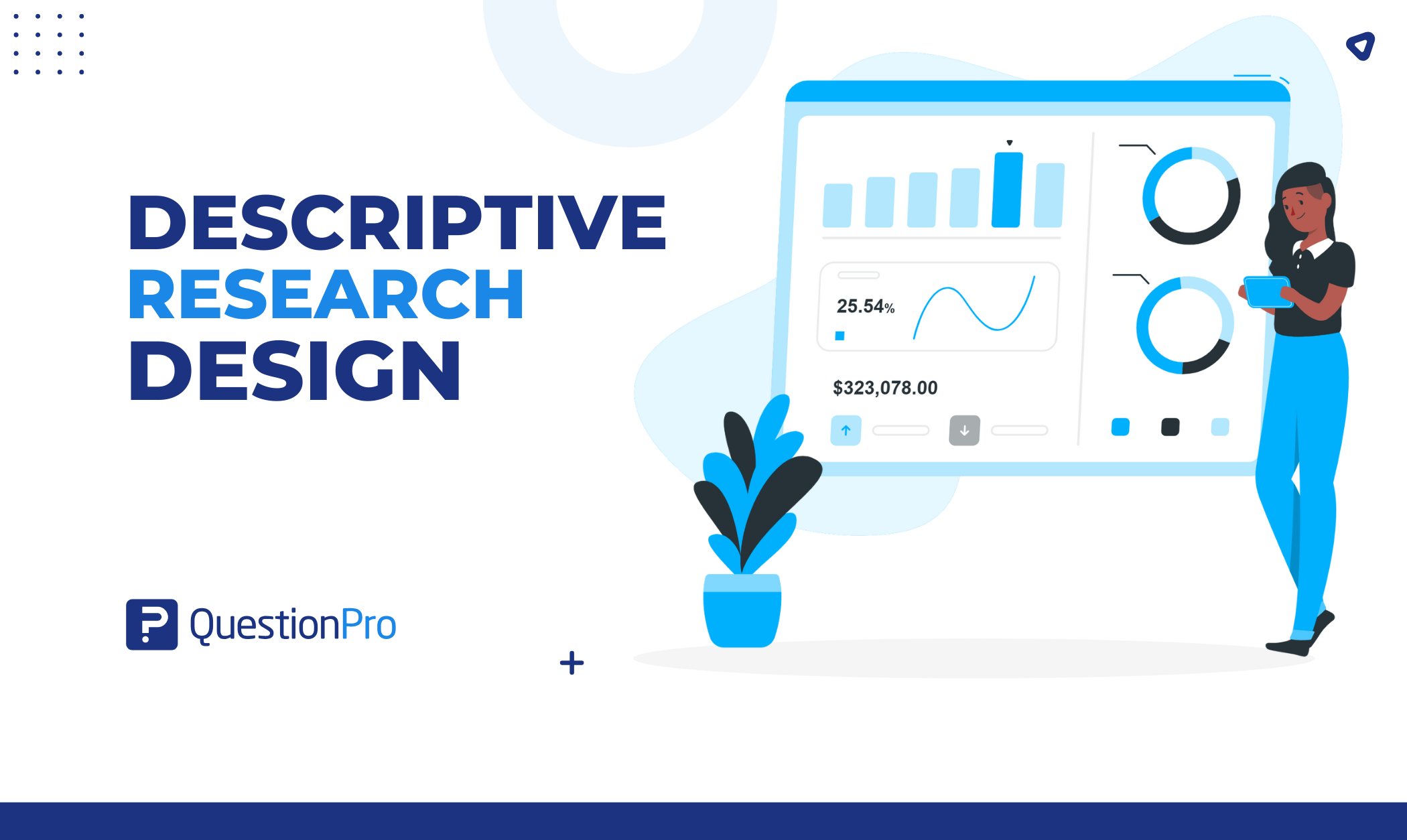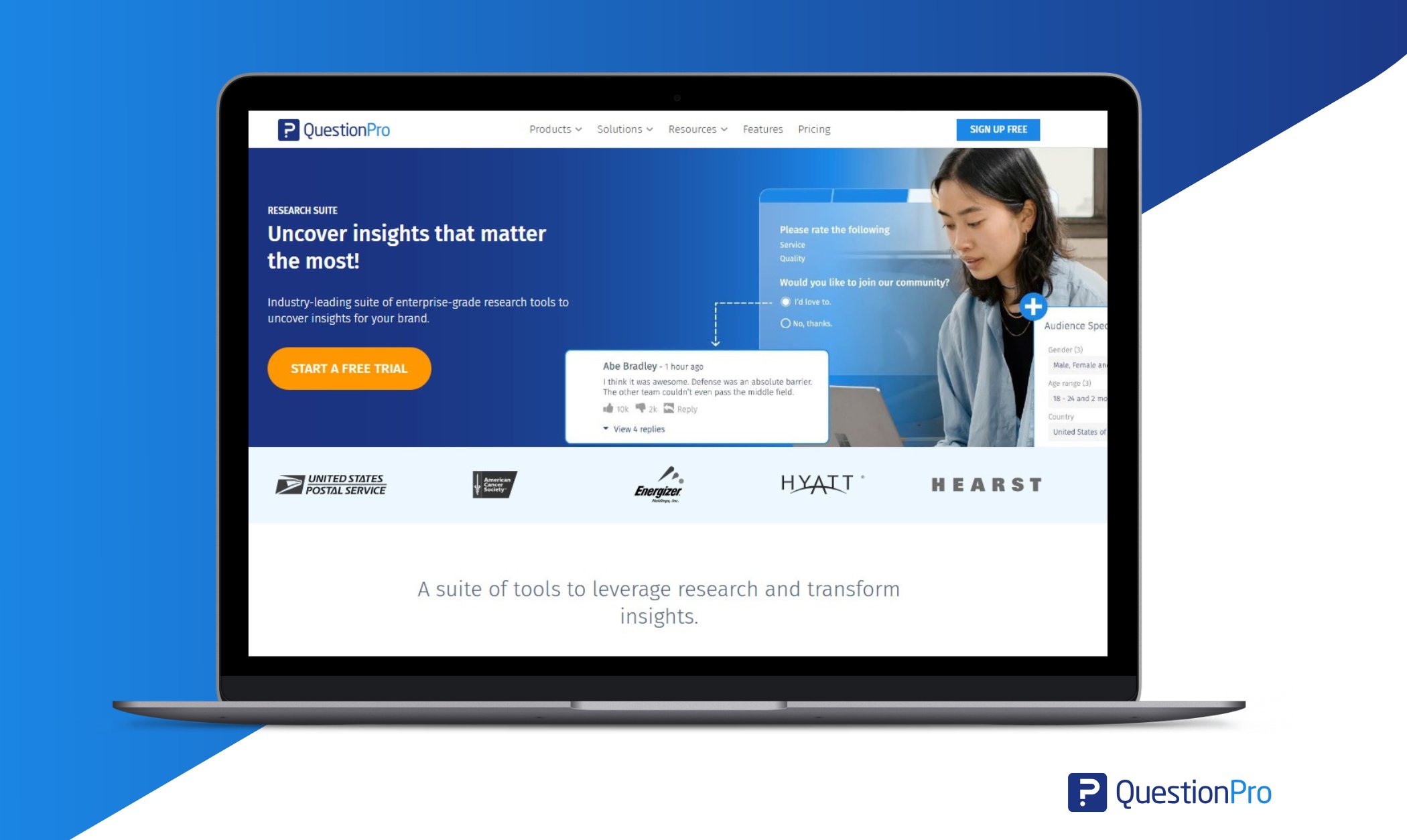
When conducting research, choosing the right method to gather data is crucial to getting meaningful and accurate results. One of the most effective and widely used approaches is descriptive research design. But what does it really mean, and how can you use it to collect data for your own study?
Imagine you’re trying to understand a specific group of people or phenomenon; perhaps you want to know how your customers feel about a new product, or you’re tracking the behavior of a target audience over time. Descriptive research is your go-to tool for capturing all the essential details and creating a clear picture of what is happening without getting lost in the complexities of why things are happening.
In this blog, we’ll explore the basics of descriptive research design, so you can collect the data that matters!
What is Descriptive Research Design?
Descriptive research design is a method used to systematically collect, analyze systematically, and present data to describe a specific population or phenomenon’s characteristics, behaviors, or patterns. It focuses on answering what rather than why by using methods like:
- Surveys
- Observations
- Case studies
This type of research is often used to identify patterns, trends, or specific attributes within a population, which can be helpful in fields like marketing, healthcare, education, and social sciences. The goal is to accurately describe the subject under study, making it easier to understand its current state and laying the groundwork for future research or decision-making.
Why is Descriptive Research Design Important?
Descriptive research design is important because it helps us understand and analyze real-world situations without making assumptions. It provides a clear idea of a subject, whether it’s customer preferences, market trends, or human behavior. Here’s why it matters:
- Gives Accurate Information: This research method collects actual data from real people, making the findings reliable and useful.
- Helps in Decision-Making: Businesses, governments, and researchers use descriptive research to make informed choices based on facts rather than guesses.
- Identifies Trends and Patterns: It helps spot changes over time, like shifts in consumer behavior or social trends, which can be useful for planning future strategies.
- Works Across Different Fields: From business and healthcare to education and social sciences, descriptive studies are used everywhere to gain valuable insights.
- Lays the Foundation for Further Research: It doesn’t explain why something happens, but it provides enough data for researchers to explore deeper causes in future studies.
In simple terms, descriptive research design helps us see the bigger picture, make better decisions, and understand the world around us with real facts!
Types of Descriptive Research Design
There are several descriptive research designs, each suited for different research goals. Here’s a simple breakdown of the main types:
1. Survey Research
Surveys are one of the most common types of descriptive research. They involve collecting data from a group of people through questionnaires or interviews. Surveys help researchers understand a large group’s opinions, behaviors, or characteristics.
For example, a company might use a survey to find out what customers think about their new product.
2. Observational Research
In this type of research, the researcher observes and records behavior or events without interfering. It can be done in natural settings (like watching how people behave in a park) or controlled environments (like a lab). Observational research is useful for studying behaviors that people might not report accurately in a survey.
3. Case Study Research
Case study research focuses on a single individual, group, or event in great detail. It provides an in-depth understanding of a specific situation. Case studies are often used in psychology, business, or education.
4. Longitudinal Research
Longitudinal research involves studying the same group of people over a long time. For example, a researcher might track the career progress of a group of graduates over 10 years. Longitudinal studies help identify patterns or changes over time.
5. Cross-Sectional Research
Unlike a longitudinal study, cross-sectional studies collect data from a particular group of people at a single point in time. It’s like taking a snapshot of a population.
6. Correlational Research
While not purely descriptive, correlational research is often grouped here because it describes the relationship between two variables. For example, a researcher might study whether there’s a link between studying hours and exam scores. However, it doesn’t prove that one variable causes the other.
Descriptive Research Methods
These methods are widely used in psychology, education, marketing, and social sciences. Let’s break down the primary descriptive research methods in a simple way:
- Surveys
Surveys are one of the most popular methods. They involve asking people questions through questionnaires or interviews. Surveys can be done online, over the phone, or in person.
- Case Studies
A case study is an in-depth look at a single person, group, or event. Researchers collect detailed information to understand a specific situation.
- Interviews
Interviews involve having one-on-one conversations with people to gather detailed information. They can be structured (with a set list of questions) or unstructured (more like a free-flowing conversation).
- Focus Groups
A focus group is a small group of people who discuss a topic while a researcher listens and takes notes. This method is often used in marketing to test new products or ideas.
- Document Analysis
This method involves studying existing records or documents to gather information. For example, a researcher might analyze school attendance records to see if the weather affects how often students miss class. Document analysis is useful because it uses existing data, saving time and effort.
Steps to Follow in Creating A Descriptive Research Design
Creating a descriptive research design may sound technical, but it’s essential for understanding how things work and why they happen the way they do. So, if you’re looking to explore a topic thoroughly, here’s an easy guide on how to create a solid descriptive research design in simple steps.

1. Define the Research Problem
Before exploring any research, it’s essential to identify the problem or question you want to examine clearly. Ask yourself:
- What do you want to know?
For example, if you’re studying the relationship between online learning and student performance, your research problem might be: How does online learning impact student engagement? This step will guide the entire design process, so take your time to think about the key areas you need to investigate.
2. Select the Research Method
Now that you know what you’re studying, it’s time to choose how you’ll gather the information. For descriptive research, you typically use methods like:
- Surveys
- Interviews or
- Observations
Decide whether you want to collect data through questionnaires (surveys), personal interviews, or observing behavior naturally. This step will shape how you interact with your subjects and gather the necessary data to describe the situation.
3. Determine the Population and Sample
Once your research method is in place, it’s time to figure out who will be involved. In descriptive research, you need a group of people (the population) that represents the larger group you’re studying.
For example, if you’re studying high school students’ attitudes toward homework, your population might be students in a specific region. After identifying the population, decide whether you’ll work with the entire group or take a sample, which is a smaller, more manageable subset of that population.
4. Choose the Data Collection Tools
After defining your population, it’s time to select the tools or instruments you’ll use to collect data.
- For surveys, this might mean designing a questionnaire with clear, unbiased questions.
- For interviews, it might mean preparing an interview guide with open-ended questions.
Make sure your tools are aligned with your research problem and can effectively capture the information you need to describe your research subject accurately.
5. Analyze and Interpret the Data
The final step in your descriptive research design involves analyzing your collected data. With descriptive research, you’re mostly interested in summarizing and presenting your findings clearly. You might calculate averages and percentages or even use charts and graphs to illustrate trends or patterns. Once the data is analyzed, you’ll interpret it to draw conclusions about your study situation.
Disadvantages of Descriptive Research Design
While descriptive research design is a useful and widely used approach, it does have some limitations. Here are the key disadvantages of descriptive research design:
- No Cause-and-Effect Relationship: Descriptive research only describes what is and doesn’t explain why something happens. It can’t establish cause-and-effect relationships.
- Limited Depth: Descriptive research often provides a surface-level understanding of a topic. While it’s great for identifying patterns or trends, it doesn’t dig deep into the underlying reasons or motivations behind behaviors.
- Risk of Bias: The results of descriptive research can be influenced by biases, especially in methods like surveys or interviews.
- Reliance on Self-Reported Data: Many descriptive research methods (like surveys and interviews) rely on self-reported data, which can be inaccurate. People might misunderstand questions, forget details, or provide incomplete answers. This can affect the reliability of the findings.
- Time-Consuming and Costly: Some descriptive research methods, like longitudinal studies or large-scale surveys, can be time-consuming and expensive to conduct. For example, tracking a group of people over several years requires significant resources and effort.
Challenges and Solutions of Descriptive Research Design
Like any research method, descriptive research design has limitations and flaws. The good news is that many of these issues can be addressed with some thoughtful planning and careful execution. Let’s look at some common deficiencies of descriptive research design and how to overcome them.
1. Lack of Causality
Descriptive research focuses on describing what is happening but doesn’t explain why it happens. This means that it cannot establish cause-and-effect relationships.
- How to Overcome It: To address this flaw, combine descriptive research with other methods to help uncover causality. For example, you could experiment or use correlational studies to explore how one factor might lead to another.
Example: If you’re studying customer satisfaction at a restaurant, you could combine observational research with customer surveys to identify patterns and then experiment to test if improving service speeds leads to higher satisfaction.
2. Limited Scope of Data
Descriptive research often focuses on a small group or a specific event, which can limit the generalizability of your findings.
- How to Overcome It: Make sure your sample size is large enough to represent the broader population. Random sampling can help you avoid biases and ensure your results are more widely applicable.
Example: If you’re surveying employee satisfaction, try to study a broad range of employees across different departments, job levels, and locations to ensure diversity in your data.
3. Observer Bias
In observational studies, the researcher’s own perceptions and opinions might affect how they interpret the data. This can lead to biased conclusions.
- How to Overcome It: You can use multiple observers to record data and compare their findings to reduce bias. Additionally, training observers to follow a specific, standardized protocol ensures everyone looks for the same behaviors or trends.
Example: If you’re observing classroom behavior, have multiple teachers or researchers record their observations independently and then compare notes to identify common trends.
4. Data Collection Errors
Descriptive research often relies on self-reported data through surveys or questionnaires, which can be prone to errors like response bias or misunderstanding of questions.
- How to Overcome It: To minimize errors, ensure your questions are clear, concise, and unbiased. Pilot-test your surveys before full implementation to spot any confusing questions. Additionally, encourage honesty in responses by making surveys anonymous or confidential.
Example: In a customer satisfaction survey, avoid leading questions like “How much did you love our service?” Instead, ask neutral questions like, “How satisfied were you with our service on a scale from 1-10?”
5. No Control Over Variables
Descriptive research does not control or manipulate variables, so factors that influence the outcome may not be considered. This can result in incomplete or biased data.
- How to Overcome It: You can include control variables when conducting your research to address this. This involves identifying potential factors that could influence your results and accounting for them in your data analysis.
Example: If you’re researching the factors that affect employee motivation, make sure to control for variables like age, job position, and experience to avoid confusing results.
Using QuestionPro Research Suite for Descriptive Research Design
Using QuestionPro Research Suite for descriptive research is a smart and efficient way to gather, analyze, and present data. Whether you’re studying customer preferences, employee satisfaction, or market trends, QuestionPro offers tools and features that make the entire research process seamless. Here’s how you can use it effectively for descriptive research:

1. Design Your Survey or Questionnaire
QuestionPro provides an intuitive platform to create surveys customized to your research goals. You can:
- Choose from pre-built templates for common research topics (e.g., customer satisfaction, employee engagement).
- Use a variety of question types (multiple-choice, rating scales, open-ended, etc.) to capture the data you need.
- Customize the survey’s design to match your branding or study theme.
2. Distribute Surveys Easily
QuestionPro allows you to share your survey through multiple channels, ensuring you reach your target audience:
- Email: Send survey invitations directly to participants.
- Social Media: Share your survey on platforms like Facebook, Twitter, or LinkedIn.
- Website Embed: Add the survey to your website or blog.
- QR Codes: Use QR codes for offline events or printed materials.
This flexibility helps you collect responses quickly and efficiently.
3. Collect Real-Time Data
As responses come in, QuestionPro updates your data in real-time. This allows you to monitor response rates and track participation. It also helps to identify trends as they emerge.
4. Analyze Data with Advanced Tools
QuestionPro offers powerful analytics tools to help you make sense of your data:
- Text Analysis: Analyze open-ended responses to identify common themes or sentiments.
- Cross-Tabulation: Compare responses across different groups (e.g., age, gender, location).
- Statistical Analysis: Calculate averages, percentages, and other key metrics.
These tools help you uncover patterns and insights that answer your research questions.
5. Conduct Observational or Longitudinal Studies
While QuestionPro is best known for surveys, it can also support other descriptive research methods:
- Use mobile-friendly surveys to collect observational data in real-time.
- Conduct longitudinal studies by sending follow-up surveys to the same group over time.
For example, if you’re studying customer behavior, you can track changes in preferences over several months.
Conclusion
Throughout this blog, we explored what descriptive research is, why it’s so important, and how to design a study that captures the essential data you need. By following the right steps and utilizing the right tools, you can collect meaningful insights and gain a deeper understanding of your research subject.
Now that you have a solid understanding of how to design and conduct descriptive research, you’re ready to start your own study and begin gathering data that truly matters.
QuestionPro Research Suite is an excellent tool for conducting descriptive research. From designing surveys to analyzing data and presenting findings, it simplifies the entire process, making it easier for you to focus on understanding and describing your research topic. Give it a try and see how it can transform your research!
Frequently Asked Questions (FAQs)
Answer: Descriptive research design helps gather detailed information, providing a clear understanding of a subject. It is crucial for identifying patterns, trends, and behaviors in various fields.
Answer: The main types of descriptive research design include observational studies, case studies, surveys, and cross-sectional studies.
Answer: Data in descriptive research design can be collected through surveys, interviews, observations, and document analysis, depending on the study’s focus.
Answer: No, descriptive research design cannot establish cause and effect. It only describes existing conditions or behaviors.
Answer: To design a descriptive research study, define the research objectives, select the target population, choose data collection methods, and analyze the results to identify patterns or trends.






